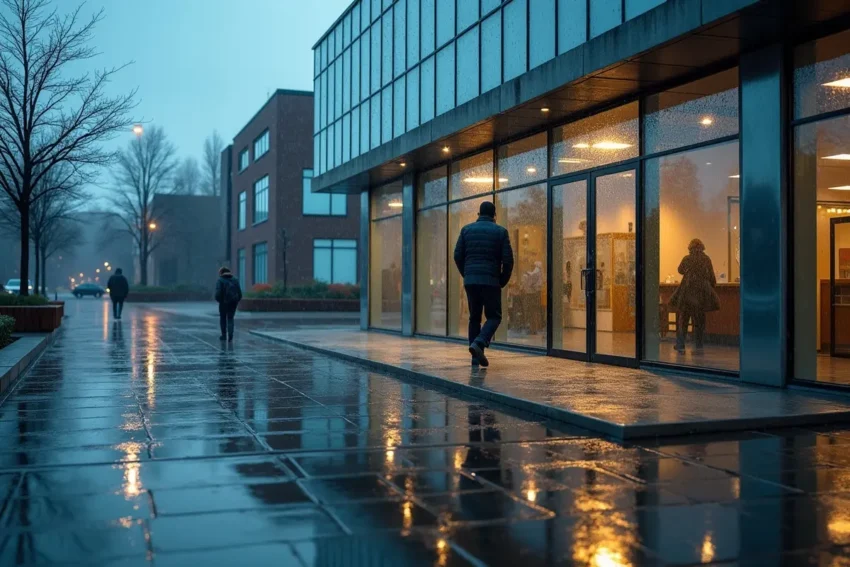Office building managers and safety professionals know the importance of creating a safe environment for employees and visitors. Yet, one overlooked hazard is how wet weather affects glass-entrance office buildings.
Rain, sleet, and snow quickly transform modern, sleek entrances into potential danger zones. Slips and falls not only injure people but can also lead to lawsuits, financial losses, and reputational damage. For guidance in handling the legal implications of these incidents, consulting Dyer, Garofalo, Mann & Schultz can provide valuable insight.
Why Glass Entrances Are Riskier in Wet Weather
Glass entrances, while attractive, pose unique challenges during storms. Smooth surfaces, such as glass and tile, offer little traction when wet. Rain and snow tracked indoors can create hidden slick spots that are difficult for visitors to see. Within minutes of a storm, a polished lobby can turn hazardous.
Key concerns include:
- Moisture build-up on smooth floors reduces traction.
- Poor visibility of thin water layers on glass and tile.
- Increased foot traffic is spreading water throughout entrances.
These factors combine to make glass-fronted office buildings more vulnerable to slip incidents than many traditional structures.
Common Causes of Slip Incidents
Several recurring problems contribute to wet-weather accidents in these environments:
- Slippery Surfaces – Smooth materials, such as polished tile and glass, lose grip quickly.
- Water Accumulation – Inadequate drainage causes puddles inside and outside entryways.
- Lack of Warning Signs – Without clear signage, visitors may not be aware that the floor is slick.
- Heavy Traffic Flow – The more people enter and exit, the faster moisture spreads throughout the indoor space.
Understanding these causes helps managers develop more effective prevention strategies.
Preventative Measures That Work
The best defense is preparation. Building managers can mitigate risk through a combination of materials, effective planning, and regular monitoring.
- Install Slip-Resistant Flooring – Anti-slip mats, textured tiles, and rubber flooring improve traction.
- Maintain Drainage Systems – Ensure drains are clear and floors are sloped to divert water away from the area.
- Use Signage and Lighting – Bright signs and well-lit areas remind everyone to proceed cautiously.
- Schedule Regular Inspections – Checking lobbies and entrances during storms helps identify hazards quickly.
These steps not only minimize legal liability but also demonstrate a commitment to safety that visitors notice and appreciate.
Innovative Safety Solutions
New technology is making safety even more effective:
- Advanced Flooring Materials – Modern surfaces feature micro-textures that maintain grip even when wet.
- Moisture Sensors – Some systems alert staff when water levels reach unsafe levels.
- Smart Drainage Designs – Sloped floors and integrated drains prevent water from pooling.
By combining traditional safety measures with innovative solutions, office buildings can significantly lower accident risks.
Examples of Proactive Safety Upgrades
Several office buildings have already made improvements that have reduced accidents:
- Slip-Resistant Flooring: Replacing entry tiles with textured composites lowered incident rates.
- Drainage Enhancements: Strategically placed drains and sloped entrances prevented puddles.
- Awareness Campaigns: Temporary signage during storms encouraged safer visitor behavior.
These real-world adjustments show how modest changes can protect both employees and visitors.
Long-Term Benefits of Safety Planning
Reducing slip hazards is about more than preventing accidents; it also enhances overall operational efficiency.
- Employee Productivity: Workers feel safer in well-maintained environments.
- Visitor Confidence: Guests and clients are more likely to return when they trust a facility’s safety.
- Legal Protection: Companies with a proactive safety record are better equipped to defend against claims.
Taking action now yields dividends in reduced costs, an improved reputation, and greater community trust.
Final Thoughts
Glass-entrance office buildings are especially vulnerable during wet weather, but managers can reduce risks through preparation, improved design, and consistent maintenance. By combining slip-resistant flooring, adequate drainage, clear signage, and innovative technologies, businesses protect both people and property.
When legal challenges arise, working with Dyer, Garofalo, Mann & Schultz ensures that building owners understand their rights and responsibilities. Proactive safety not only prevents accidents but also reinforces a company’s image as a responsible and trustworthy organization.

